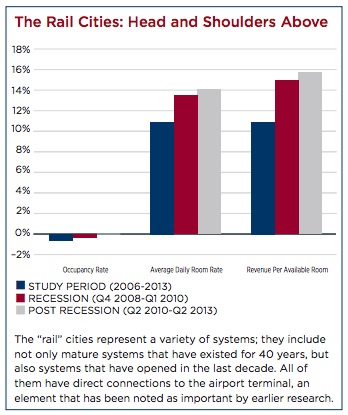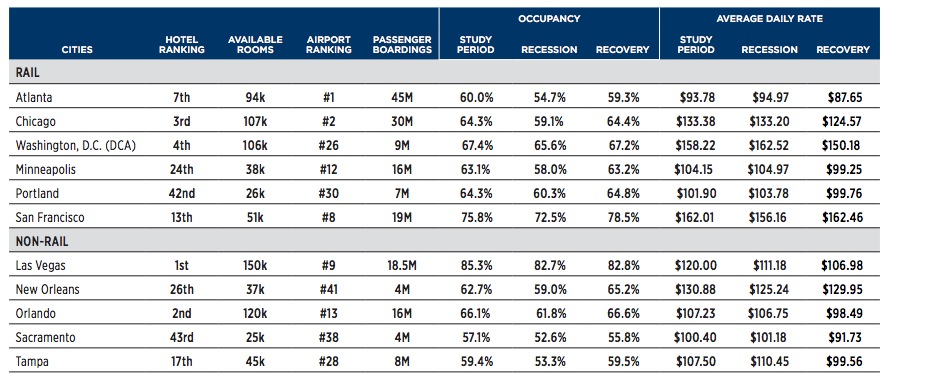AMERICAN PUBLIC TRANSPORTATION ASSOCIATION
U.S. TRAVEL ASSOCIATION
Executive Summary
 As fewer Americans are driving cars and recent generational trends show an exodus from rural areas into cities and suburbs with interconnected transit and walkable alternatives, locations that offer multimodal transportation systems are increasingly popular places to live. However, new historical data analysis proves that these same cities are desirable places to travel to as well.
As fewer Americans are driving cars and recent generational trends show an exodus from rural areas into cities and suburbs with interconnected transit and walkable alternatives, locations that offer multimodal transportation systems are increasingly popular places to live. However, new historical data analysis proves that these same cities are desirable places to travel to as well.
Mobility Attracts More Travelers
Cities with rail transit service or “rail cities” direct from the nearby, heavily trafficked airport to hotels realize increased economic vitality and competitiveness to attract large meetings and events compared to similar cities that do not, or “non-rail cities.” In fact, when examining rail cities’ hotel performance in contrast to non-rail cities over the past six years (from 2006 into 2013), including during the Great Recession, hotel performance was on average 10.9 percent better in terms of both average daily rate charged for hotel rooms and revenue earned per available room.
When narrowing the focus to hotel properties located in close proximity (within 1/4 mile of a rail station) of these interconnected transit options, performance was even better, with an average 12.5 percent higher occupancy rate and nearly 50 percent higher (48.6%) average daily room rates.
These findings suggest that hotel properties located in rail cities and within close proximity to rail transit stations are realizing both improved economic vitality and increased attractiveness when it comes to seizing an increased share of travelers.
Moreover, when looking at the highest class (luxury and upper upscale) properties within the hotel segment, which captures much of the business travel and convention attendee portion of the travel market, similarly stronger performance is realized in rail cities versus non-rail cities. This improved performance of rail cities over non-rail cities is apparent even when the non-rail cities have comparable – or stronger – supply of available hotel rooms and volume of air travelers, which provides a major competitive advantage for attracting and securing business travel, including meetings and conventions.
Business travel, including meetings, conventions and events, represents a substantial force in the U.S. economy. In 2012, according to the U.S. Travel Association, business travel generated $258.6 billion, supported 2.2 million American jobs and generated $39.8 billion in tax revenue.
These business meetings and conventions are not limited to American attendees. In fact, international travelers accounted for 14.6 percent of total business travel spending in 2012, which generated nearly $38 billion, supported 332,000 American jobs and generated $5.7 billion in tax revenue. Intermodal infrastructure that provides direct transit service from our nation’s airports to these convention cities not only makes rail cities more advantageous than non-rail cities, but also provides a competitive edge in winning global business meetings, conventions and events.
As federal, state and local policymakers consider future investments, it’s clear that funding and flexibility either to improve or to create intermodal connections within America’s cities will have real and measurable economic growth and benefits.
Download full version (PDF): A New Partnership
About the American Public Transportation Association
www.apta.org
“To strengthen and improve public transportation, APTA serves and leads its diverse membership through advocacy, innovation and information sharing. APTA and its members and staff work to ensure that public transportation is available and accessible for all Americans in communities across the country.”
About the U.S. Travel Association
www.ustravel.org
“U.S. Travel is the unique national organization that leverages the collective strength of those who benefit from travel to grow their business beyond what they can do individually.”
Tags: airports, American Public Transportation Association, Convention Centers, Hotels, U.S. Travel Association







 RSS Feed
RSS Feed